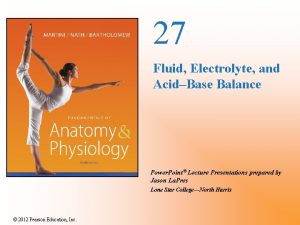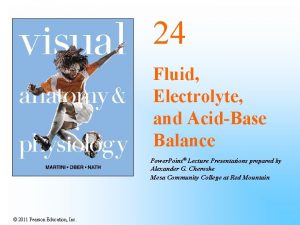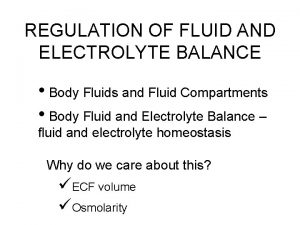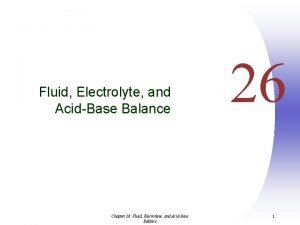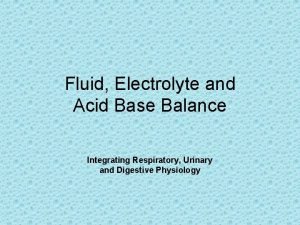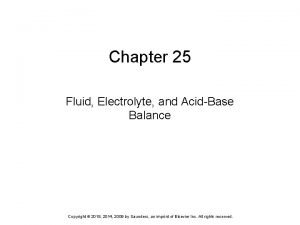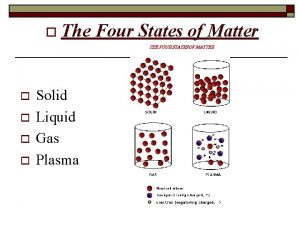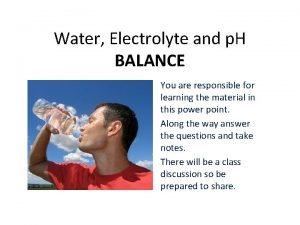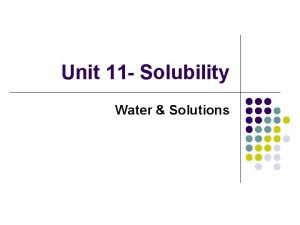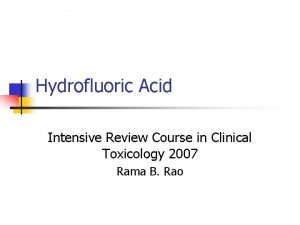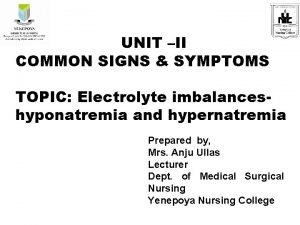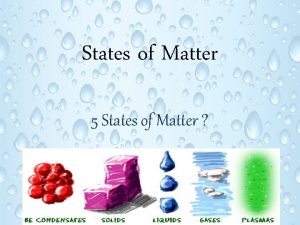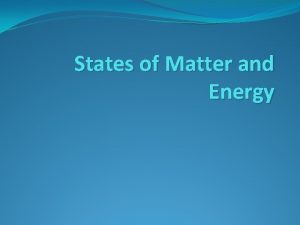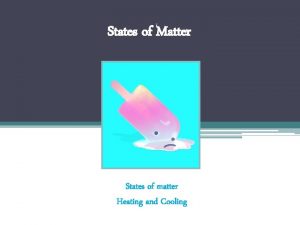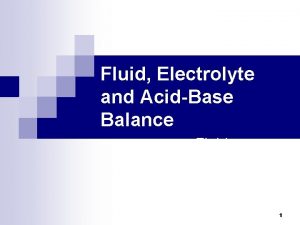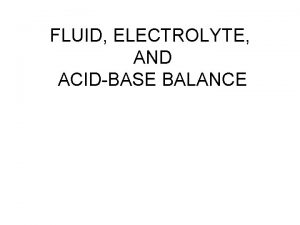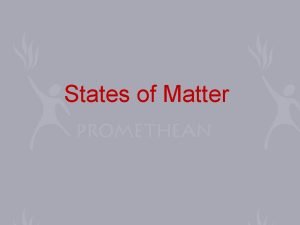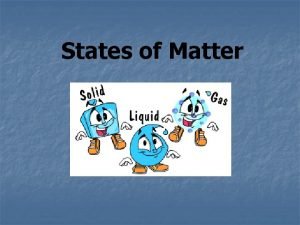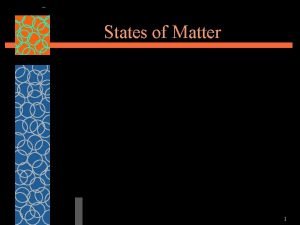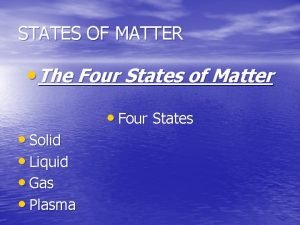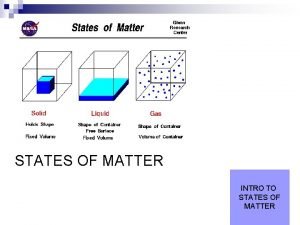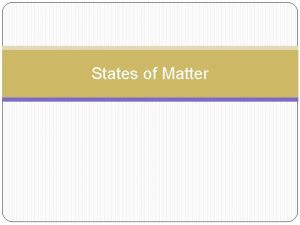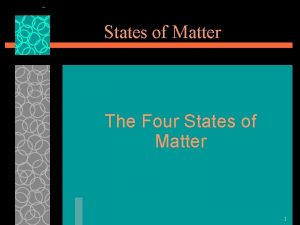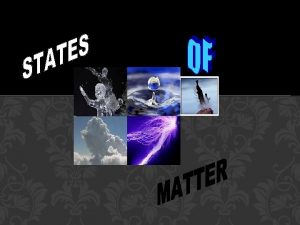The States of matter Electrolyte and non electrolyte

















- Slides: 17

The States of matter

Electrolyte and non electrolyte solutions: • The solutes (whether gases, liquids, or solids) are divided into two main classes: nonelectrolytes and electrolytes. Nonelectrolytes are substances that do not ionize when dissolved in water and therefore do not conduct an electric current through the solution. Examples of nonelectrolytes are sucrose, glycerin, naphthalene, and urea.

Electrolytes are substances that dissolve in water and form ions in solution (anion and cation), conduct electric current, and show apparent “anomalous” colligative properties; that is, they produce a considerably greater freezing point depression and boiling point elevation than do nonelectrolytes of the same concentration. Examples of electrolytes are hydrochloric acid, sodium sulfate, ephedrine, and phenobarbital.

Electrolytes may be subdivided further into strong electrolytes which are completely ionized and conduct a strong electrical current such as sodium chloride, and weak electrolytes that are only slightly ionized in aqueous solution and conduct electrical current weakly (eg. ephedrine and phenobarbital are weak electrolytes).

• Ideal and Real Solutions Ideal solution as one in which there is no change in the properties of the components, other than dilution, when they are mixed to form the solution. No heat is evolved or absorbed during the mixing process, and the final volume of the solution represents an additive property of the individual constituents. Stated another way, no shrinkage or expansion occurs when the substances are mixed. The constitutive properties, for example, the vapor pressure, refractive index, surface tension, and viscosity of the solution, are the weighted averages of the properties of the pure individual constituents.

• Mixing substances with similar properties forms ideal solutions. For example, when 100 m. L of methanol is mixed with 100 m. L of ethanol, the final volume of the solution is 200 m. L, and no heat is evolved or absorbed. The solution is nearly ideal. When 100 m. L of sulfuric acid is combined with 100 m. L of water, however, the volume of the solution is about 180 m. L at room temperature, and the mixing is attended by a considerable evolution of heat; the solution is said to be nonideal, or real.

Liquefaction of Gases: • When a gas is cooled, it loses some of its kinetic energy in the form of heat, and the velocity of the molecules decreases. If pressure is applied to the gas, the molecules are brought within the sphere of the van der Waals • Because of these forces, liquids are considerably denser than gases and occupy a definite volume. • Gas will pass into the liquid state. • The transitions from a gas to a liquid and from a liquid to a solid depend not only on the temperature, but also on the pressure to which the substance is subjected.

• If the temperature is elevated sufficiently, a value is reached above which it is impossible to liquefy a gas, irrespective of the pressure applied. • This temperature, above which a liquid can no longer exist, is known as the critical temperature. • The pressure required to liquefy a gas at its critical temperature is the critical pressure, which is also the highest vapor pressure that the liquid can have.

• The further a gas is cooled below its critical temperature, the less pressure is required to liquefy it. Based on this principle, all known gases have been liquefied. • The critical temperature serves as a rough measure of the attractive forces between molecules, at temp. above critical value, the molecules possess sufficient kinetic energy so that no amount of pressure can bring them within the range of attractive forces that cause the particles to "stick" together.

Methods for Achieving Liquefaction: One of the ways to liquefy a gas is to subject it to intense cold by the use of freezing mixtures. Other methods depend on the cooling effect produced in a gas as it expands. Thus, suppose we allow an ideal gas to expand so rapidly that no heat enters the system. Such an expansion, termed an adiabatic expansion, may be achieved by carrying out the process in a vacuum flask, which effectively insulates the contents of the flask from the external environment.

The work that has to be done to bring about expansion therefore must come from the gas itself at the expense of its own heat energy content. As a result, the temperature of the gas falls. If this procedure is repeated a sufficient number of times, the total drop in temperature is sufficient to cause liquefaction of the gas.

Aerosols: Gases can be liquefied by increasing pressure, provided we work below the critical temp. When the pressure is reduced, the molecules expand the liquid reverts to a gas. This reversible change of state is the basic principle involved in the preparation of pharmaceutical aerosols. In such products, the drug is dissolved or suspended in a 'propellant',

propellant: a material that is liquid under the pressure conditions existing inside the container and forms a gas under normal atmospheric conditions. Chlorofluorocarbons and hydrofluorocarbons have traditionally been utilized as propellants in these products because of their physicochemical properties, However, in the face of increasing environmental concerns (ozone depletion) their use is tightly regulated which has led to the increased use of other gases such as nitrogen and carbon dioxide.

• Vapor Pressure of Liquids Translational energy of motion (kinetic energy) is not distributed evenly among molecules; some of the molecules have more energy and hence higher velocities than others at any moment. When a liquid is placed in an evacuated container at a constant temperature, the molecules with the highest energies break away from the surface of the liquid and pass into the gaseous state, and some of the molecules subsequently return to the liquid state, or condense.

When the rate of condensation equals the rate of vaporization at a definite temperature, the vapor becomes saturated and a dynamic equilibrium is established. The pressure of the saturated vapor above the liquid is then known as the equilibrium vapor pressure. If a manometer is fitted to an evacuated vessel containing the liquid, it is possible to obtain a record of the vapor pressure in millimeters of mercury. The presence of a gas, such as air, above the liquid decreases the rate of evaporation, but it does not affect the equilibrium pressure of the vapor.

• As the temperature of the liquid is elevated, more molecules approach the velocity necessary for escape and pass into the gaseous state. As a result, the vapor pressure increases with rising temperature.

Thank you for listening
 Fluid and electrolyte balance ppt
Fluid and electrolyte balance ppt Role of lungs and kidneys in acid base balance
Role of lungs and kidneys in acid base balance Body fluid and electrolyte balance
Body fluid and electrolyte balance An atypical accumulation of fluid in the interstitial space
An atypical accumulation of fluid in the interstitial space Anp
Anp Normal values of potassium
Normal values of potassium Oo solid
Oo solid Grey vs white matter
Grey vs white matter Median and lateral apertures
Median and lateral apertures Gray matter and white matter
Gray matter and white matter Frontal and parietal lobes
Frontal and parietal lobes Chapter 11 - states of matter: liquids and solids
Chapter 11 - states of matter: liquids and solids Veux tu briser du péché le pouvoir parole
Veux tu briser du péché le pouvoir parole Water electrolyte imbalance
Water electrolyte imbalance Solubility
Solubility Hf electrolyte
Hf electrolyte Freddy santoso
Freddy santoso Nursing diagnosis for vomiting
Nursing diagnosis for vomiting
